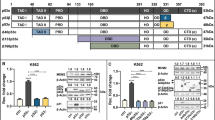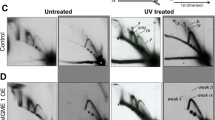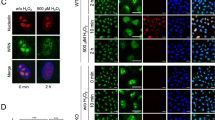Abstract
The tumor suppressor p53 protein stimulates nuclear base excision repair (BER) in vitro. In response to certain cellular stresses, p53 translocates to mitochondria, where it can trigger an apoptotic response. However, a potential role for p53 in modulating mitochondrial DNA repair has not yet been examined. In this study, we show that p53 also modulates mitochondrial BER. Uracil-initiated BER incorporation, which measures flux through the entire BER pathway, was lower in mitochondrial extracts from nonstressed p53 knockout mice than in wild type. The addition of recombinant p53 complemented the BER incorporation in p53 knockout extracts and stimulated BER in wt extracts. The activities of three major mitochondrial DNA glycosylases were similar in extracts from wild-type and knockout animals. Likewise, AP endonuclease activity was unaffected by the absence of p53. Gel shift experiments with recombinant p53 demonstrated that p53 did not bind to the uracil-containing substrate used in the repair assay. Polymerase γ gap-filing activity was less efficient in p53 knockout extracts, but it was complemented with the addition of recombinant p53. Thus, we conclude that p53 may participate in mtBER by stimulating the repair synthesis incorporation step.
This is a preview of subscription content, access via your institution
Access options
Subscribe to this journal
Receive 50 print issues and online access
$259.00 per year
only $5.18 per issue
Buy this article
- Purchase on Springer Link
- Instant access to full article PDF
Prices may be subject to local taxes which are calculated during checkout







Similar content being viewed by others
Abbreviations
- AP:
-
apurinic/apyrimidinic
- BER:
-
base excision repair
- MLME:
-
mouse liver mitochondrial extract
- MLNE:
-
mouse liver nuclear extract
- mtBER:
-
mitochondrial base excision repair
- mtDNA:
-
mitochondrial DNA
- NTH1:
-
endonuclease III homologue 1
- OGG1:
-
oxoguanine DNA glycosylase
- Pol γ:
-
DNA polymerase gamma
- U:
-
uracil
- UDG:
-
uracil DNA glycosylase
References
Allinson SL, Dianova II and Dianov GL . (2001). EMBO J., 20, 6919–6926.
Bohr VA, Stevnsner T and Souza-Pinto NC . (2002). Gene, 286, 127–134.
Degtyareva N, Subramanian D and Griffith JD . (2001). J. Biol. Chem., 276, 8778–8784.
Domena JD and Mosbaugh DW . (1985). Biochemistry, 24, 7320–7328.
Dumont P, Leu JI, Della III PA, George DL and Murphy M . (2003). Nat. Genet., 33, 357–365.
Evans AR, Limp-Foster M and Kelley MR . (2000). Mutat. Res., 461, 83–108.
Evans MK, Taffe BG, Harris CC and Bohr VA . (1993). Cancer Res, 53, 5377–5381.
Foord OS, Bhattacharya P, Reich Z and Rotter V . (1991). Nucleic Acids Res., 19, 5191–5198.
Gaiddon C, Moorthy NC and Prives C . (1999). EMBO J., 18, 5609–5621.
Habano W, Sugai T, Nakamura SI, Uesugi N, Yoshida T and Sasou S . (2000). Gastroenterology, 118, 835–841.
Hanawalt PC . (2002). Oncogene, 21, 8949–8956.
Hofseth LJ, Khan MA, Ambrose M, Nikolayeva O, Welliver MX, Kartalou M, Hussain SP, Roth RB, Zhou X, Mechanic L, Zurer I, Rotter V, Samson LD and Harris CC . (2003). J. Clin. Invest., 112, 1887–1894.
Karahalil B, Souza-Pinto NC, Parsons JL, Elder RH and Bohr VA . (2003). J. Biol. Chem., 278, 33701–33707.
Krokan HE, Drablos F and Slupphaug G . (2002). Oncogene, 21, 8935–8948.
Krokan HE, Standal R and Slupphaug G . (1997). Biochem. J., 325, 1–16.
Lakshmipathy U and Campbell C . (1999). Mol. Cell. Biol., 19, 3869–3876.
Lee S, Elenbaas B, Levine A and Griffith J . (1995). Cell, 81, 1013–1020.
Longley MJ, Prasad R, Srivastava DK, Wilson SH and Copeland WC . (1998). Proc. Natl. Acad. Sci. USA, 95, 12244–12248.
Marchenko ND, Zaika A and Moll UM . (2000). J. Biol. Chem., 275, 16202–16212.
Meira LB, Cheo DL, Hammer RE, Burns DK, Reis A and Friedberg EC . (1997). Nat. Genet., 17, 145.
Mihara M, Erster S, Zaika A, Petrenko O, Chittenden T, Pancoska P and Moll UM . (2003). Mol. Cell, 11, 577–590.
Moll UM and Zaika A . (2001). FEBS Lett., 493, 65–69.
Nilsen H, Otterlei M, Haug T, Solum K, Nagelhus TA, Skorpen F and Krokan HE . (1997). Nucleic Acids Res., 21, 2579–2584.
Offer H, Milyavsky M, Erez N, Matas D, Zurer I, Harris CC and Rotter V . (2001). Oncogene, 20, 581–589.
Offer H, Wolkowicz R, Matas D, Blumenstein S, Livneh Z and Rotter V . (1999). FEBS Lett., 450, 197–204.
Seo YR, Fishel ML, Amundson S, Kelley MR and Smith ML . (2002). Oncogene, 21, 731–737.
Sobol RW, Kartalou M, Almeida KH, Joyce DF, Engelward BP, Horton JK, Prasad R, Samson LD and Wilson SH . (2003). J. Biol. Chem., 278, 39951–39959.
Souza-Pinto NC, Croteau DL, Hudson EK, Hansford RG and Bohr VA . (1999). Nucleic Acids Res., 27, 1935–1942.
Souza-Pinto NC, Eide L, Hogue BA, Thybo T, Stevnsner T, Seeberg E, Klungland A and Bohr VA . (2001). Cancer Res., 61, 5378–5381.
Stierum RH, Dianov GL and Bohr VA . (1999a). Nucleic Acids Res., 27, 3712–3719.
Stierum RH, Dianov GL and Bohr VA . (1999b). Nucleic Acids Res., 27, 3712–3719.
Stuart JA, Karahalil B, Hogue BA, Souza-Pinto NC and Bohr VA . (2004). FASEB J., 18, 595–597.
Taguchi T, Ogihara M, Maekawa T, Hanaoka F and Tanno M . (1995). Biochem. Biophys. Res. Commun., 216, 715–722.
Vogelstein B, Lane D and Levine AJ . (2000). Nature, 408, 307–310.
Wang XW, Yeh H, Schaeffer L, Roy R, Moncollin V, Egly JM, Wang Z, Freidberg EC, Evans MK and Taffe BG . (1995). Nat. Genet., 10, 188–195.
Wilson III DM, Takeshita M, Grollman AP and Demple B . (1995). J. Biol. Chem., 270, 16002–16007.
Yamada NA and Farber RA . (2002). Cancer Res., 62, 6061–6064.
Zhou J, Ahn J, Wilson SH and Prives C . (2001). EMBO J., 20, 914–923.
Zurer I, Hofseth LJ, Cohen Y, Xu-Welliver M, Hussain SP, Harris CC and Rotter V . (2004). Carcinogenesis, 25, 11–19.
Acknowledgements
We thank Drs Cayetano Von Kobbe and Syed Imam for the critical reading of this manuscript. We also thank Dr Draginja Djurickovic (NCIFCRF) for transferring the animals.
Author information
Authors and Affiliations
Corresponding author
Rights and permissions
About this article
Cite this article
de Souza-Pinto, N., Harris, C. & Bohr, V. p53 functions in the incorporation step in DNA base excision repair in mouse liver mitochondria. Oncogene 23, 6559–6568 (2004). https://doi.org/10.1038/sj.onc.1207874
Received:
Revised:
Accepted:
Published:
Issue Date:
DOI: https://doi.org/10.1038/sj.onc.1207874
Keywords
This article is cited by
-
Bridged Analogues for p53-Dependent Cancer Therapy Obtained by S-Alkylation
International Journal of Peptide Research and Therapeutics (2016)
-
Mitochondrial DNA maintenance: an appraisal
Molecular and Cellular Biochemistry (2015)
-
The role of DNA damage responses in p53 biology
Archives of Toxicology (2015)
-
Minimizing the damage: repair pathways keep mitochondrial DNA intact
Nature Reviews Molecular Cell Biology (2012)
-
Awakening guardian angels: drugging the p53 pathway
Nature Reviews Cancer (2009)



